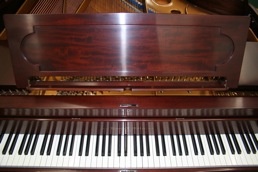Historic temperaments have been making a return to vogue in the piano tuning and performing professions in recent years. This return to favor is due in no small part to the extensive research and assimilation of information by individuals like Owen Jorgenson, RPT, Bradley Lehman, Jason Kanter and others. Because of this growing interest in the variety of Historical Tunings available it only makes sense to offer these tunings as part of a normal service routine.
What is an Historic Temperament?
Perhaps it is simpler to start by briefly discussing the commonly accepted practice of today – Equal Temperament. There are dozens and dozens of ways to tune keyboard instruments, and the most common way is to tune to Equal Temperament. If you do not request otherwise, most piano technicians will tune your piano to Equal Temperament. In Equal Temperament, all the notes on the piano are equally spaced from each other in terms of pitch. One of the chief advantages of Equal Temperament is that it allows you play pieces with widely differing key signatures equally well – F Sharp Minor sounds as good as C major in equal temperament. This advantage is also Equal Temperaments chief deficiency.
Why tune pianos with Historic Temperaments?
In a phrase, “key-color.” Historic (or, unequal) Temperaments make use of varying the spacing of the notes on the keyboard which then gives different key signatures a different musical feeling, or, color. This kind of altered spacing can make a notable difference, particularly in pieces where the composer makes significant changes of key signature from movement to movement, or within a particular movement or piece.
Of course, this addition of key color comes at a cost. Historic Temperaments have limitations in the form of “Wolf” intervals – intervals that become too noisy to be usable. So the selection of a particular temperament must consider the music most likely to be played on the instrument. Historic Temperaments can be broken down into a few sub-categories, listed from most “aggressive” to least, those categories are: meantone, modified meantone, well, victorian well, quasi-equal, or equal. By selecting appropriately from one of these categories, one can maximize their satisfaction in their chosen tuning.
Q. What if I don’t like a particular temperament?
A. In most home settings, it is not difficult to change from one temperament to another, so should you decide you don’t care for a particular tuning, it can easily be changed to a different one at your next tuning appointment.
Q. I still want my piano tuned to standard pitch, though, can you do that?
A. Tuning an Historic Temperament does not imply that we are no longer tuning to the international pitch standard of A=440Hz, so the pitch of your piano will still be where it is expected to be.
Q. I often play with other instruments or with a singer, won’t an Historic Tuning make that difficult?
A. Quite simply, No. Tuning Historically does not preclude playing with other instruments or voice in any way.
If you have interest in trying out an Historic Tuning, please contact me for more information or to schedule an appointment. The decision to choose an Historic Tuning can even be made at the moment we commence the tuning process, so don’t be bashful about inquiring at the time of your visit.


